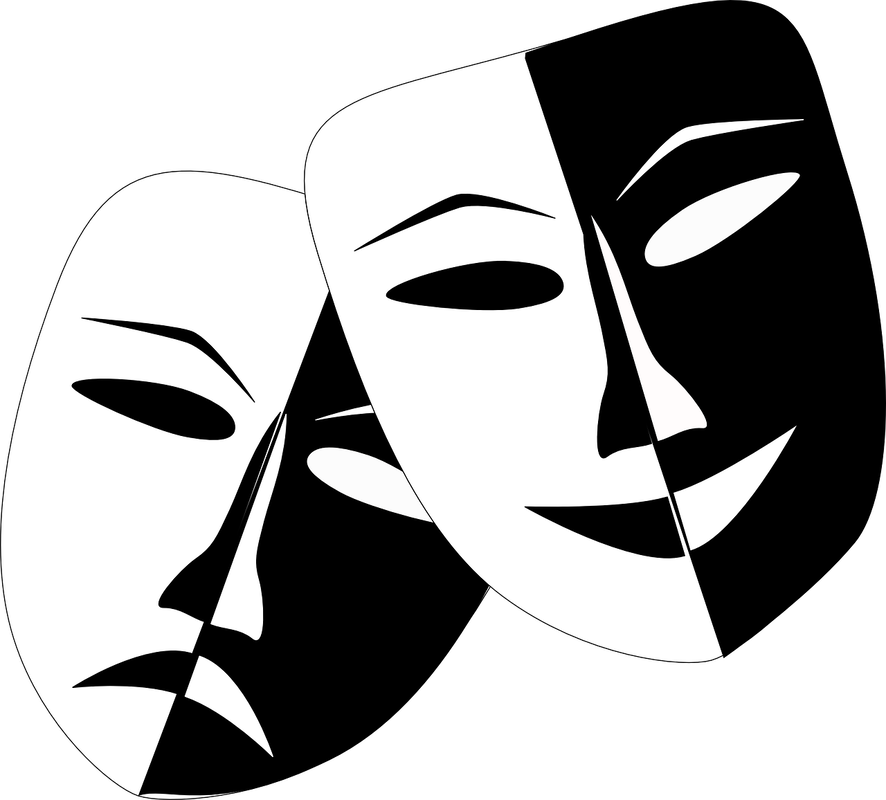|
People often confuse improv with comedy. It can be funny but voice actors, actors, performers, comics don't go for 'the laugh,' they go for the story, then the laugh will follow, if it's there. A few definitions first: Improvisation is an unscripted and unplanned live performance, often taken from the actor’s experience and imagination. The goal is to tell stories from simple cues or ideas without a script. Improv has been around from at least the time of the ancient Greeks. Modern improv has been molded in part by Del Close, Charna Halpern, and Kim Johnson, who co-authored the famed improv bible ‘Truth in Comedy The Manual of Improvisation.’ Long form, 30 minutes or more is called a ‘Harold.' The idea is that a story is made up on the spot, from an audience member’s suggestion of any random word like ‘banana’ or ‘washing machine’ for example. After the word suggestion is given, a story or scene is played out amongst an improv group of 6-8 performers. Shorter form can be done with 2 actors or even in a monologue. The idea is to go with the prompt and ‘Yes and…’ to any suggestion given to further the scene. If you say no to the suggestion, you have nowhere to go and the scene ends. It’s actually a good rule for life too, say yes and be open to the possibilities. Improv is a tool…Actors study improv because it makes them fast on their feet, quick to react, especially if things go wrong in a scene. It also takes the script off the page and allows actors to find the character or story much easier. In VoiceOver, often but not always, the voice actor is performing a monologue alone. Using improv can help make the script sound more like a dialogue. Some actors improvise a ‘lead-in’ or 'moment before,' which is a sentence that’s not in the actual script, but helps the actor find and access the character quickly. This line is often removed during post production, as it was never in the actual script itself. Sometimes a voice actor will add vocalized sounds like 'ahh, ooh, aha, uh-huh, hmmm’ to make the script sound real and leave them in the audition or actual script if appropriate. This works especially with dialogue parts in commercials, video games and animation. There are lots of warm-up improv exercises actors use to keep them loose and open to reacting. A well-known beginner game is ZIP, ZAP, ZOP. This game has the actors in a circle and making direct contact with a chosen player, passing energy by visually throwing the word ‘Zip, Zap or Zop' sequentially and upping the speed as the game continues, not losing their place and starting again when mistakes are made. That wasn't in the Script...I thought it would be fun to recount some famous improvised moments from movies that were never in the script. Here are some examples gleaned from the web. ‘I’m funny, how? I mean funny like I’m a clown? I amuse you?’ This frenetic 'Funny Like A Clown' scene from the 1990 film ‘GoodFellas’ wasn’t actually improvised live on film but in a rehearsal. Ray Liotta recounted the story at the 25th anniversary of Goodfellas held at the TriBeCa Film Festival. Joe Pesci who plays Tommy DeVito and Ray Liotta as Henry Hill were the only actors who knew the scene would be improvised when it was originally tried out in rehearsal. This allowed Martin Scorsese, the director to see the genuine expressions of the other actors. It’s based on a story Pesci told when he was working as a young waiter in Queens. He told a connected guy, he thought the mobster was funny, the mob guy did not think Pesci was very funny. Scorsese then wrote the improvised rehearsal into the script. A documentary about the film recounts that Scorsese decided to shoot in medium takes, avoiding close-ups so he could capture the real reactions of all the actors. Actor Matthew McConaughey ad-libbed ‘Alright, alright, alright’ as the character David Wooderson in the 1993 movie ‘Dazed and Confused’, his ‘first scene ever on film.’ McConaughey was listening to the Doors and heard Jim Morrison chant ‘all right, all right, all right, all right.’ That got McConaughey thinking about his character’s interests and intentions. He explained to Canadian talk show host George Stroumboulopoulos ‘Man, he’s about four things: He’s about his car, he’s about getting high, he’s about rock n’ roll, and picking up chicks,’ And I go, ‘I’m in my car, I’m high as a kite, I’m listening to rock ‘n’ roll… Action! And there’s the chick — alright, alright, alright. Three out of four.’ He repeated the catchphrase during his 2014 Academy Award for Best Actor in ‘Dallas Buyers Club.’ ‘You're gonna need a bigger boat,’ said by Roy Scheider’s Chief Brody character in the 1976 film Jaws. Crew members complained about a much too small barge called the S.S. Garage Sale, which was used to carry craft services, lighting, and film equipment. Co-screenwriter Carl Gottlieb recounted to ‘The Hollywood Reporter’ Richard Zanuck and David Brown were very stingy producers, so everyone kept telling them, ‘You’re gonna need a bigger boat.’ It became a catchphrase for anytime anything went wrong—if lunch was late or the swells were rocking the camera, someone would say, 'You're gonna need a bigger boat.’ Actor Roy Scheider started ad-libbing the line at various points in the film but only when he first faced off the Great White shark did the line make the final cut of the movie. 'It was so appropriate and so real and it came at the right moment, thanks to Verna Fields's editing,' Gottlieb said. Though it was actually used 4 times in the classic 1942 Casablanca film, the most memorable one is when Humphrey Bogart, as Rick Blaine says farewell to Ingrid Bergman’s IIsa Lund ‘Here's looking at you, kid.” The original line was actually written as ‘Here’s good luck to you, kid,’ which was a popular expression in the 1930s. A theory is that Bogie was teaching Ingrid to play poker during their downtime filming the movie. Here’s looking at you’ is when the face cards King, Queen, and Jack are all ‘looking at you.' Voice Actors know that sometimes just one improvised vocalized sound or word can define a role or audition. This is the case in the 1991 thriller ‘Silence of the Lambs’ when Anthony Hopkins as Hannibal Lector utters his scripted line about eating a liver ‘with some fava beans and a nice Chianti,’ he then improvises a haunting hissing sound to intimidate Jodie Foster’s FBI Agent Clarice Starling. Turns out Hopkins used to make that sound during rehearsals to spook Foster. Director Jonathan Demme decided it was so good, he would leave it in the movie. Honorable mention to...Whoopi Goldberg as Oda Mae Brown's sage warning to Demi Moore’s character Molly Jensen in the 1990 movie ‘Ghost,’ ‘Molly, you in danger girl.’ Jack Nicholson as obsessed writer Jack Torrance in the 1980 film ‘The Shining,’ ‘Here’s Johnny’ which is a take-off on Ed McMahon’s intro of host Johnny Carson on The Tonight Show. Robert De Niro as Travis Bickle in the 1976 cult film ‘Taxi Driver’ in the often quoted ‘You Talkin’ to Me?’ There is debate whether DeNiro got the idea from Bruce Springsteen, who once said to fans screaming his name at a concert ‘Are you talking to me?’ Springsteen thinks it’s an urban myth, Scorsese thought it might be true in a conversation between Springsteen and Marty celebrating ‘Springsteen on Broadway.’ What is known is that the direction from Scorsese was to look into the mirror and have a conversation. No words were in the direction and DeNiro kept repeating the infamous line, which has now become one of the most famed movie lines in history. Yeah, but I'm not an Actor...You don’t have to be an actor or comic to gain value from improv. Many professionals like lawyers, salespeople, realtors, teachers, managers, and many more can benefit. The goal isn’t to be funny, but to allow things to happen, be open to new ideas, develop excellent listening skills, and be present in the moment, not on to the next thing. Want More?I’ve taken classes at all three of the places listed below and recommend them. Places to study improv both in-person and online:
United Citizens Brigade in NYC: https://ucbcomedy.com The Peoples Improv Theater in NYC ‘The Pit’ https://thepit-nyc.com Magnet Theater: https://magnettheater.com/class/ I haven’t studied at Second City, but it has a highly respected reputation for improv and comedy classes with locations in Chicago, Toronto, Hollywood, and online. https://www.secondcity.com. Have any favorite improvised movie lines or scenes? Please let me know in the comments! Thanks for reading!! Nancy Kaszerman is a professional voice talent for over 10 years and is located in NYC. Please feel free to comment, ask a question and connect on social media.
2 Comments
As a voiceover artist one of the first things you learn is to get rid of any regionalisms, (which is how a person speaks based on location), and speak in a Neutral North American accent (provided you are an American) as this is considered Standard American English in broadcasting. When you use a neutral North American accent in voiceover it generally means you can’t tell where the person is from, which is often preferable for voice-over castings, video productions, TV, film, commercials, e-learning and more! But things are changing and sometimes casting directors do want a talent from a certain location and it’s okay to have regionalisms, and in fact it’s preferred, depending on where the spot is going to air. For example a spot airing in NYC might not want a Southern accent unless of course, the character requires it for the role. Full disclosure, while I’ve lived in New York City for decades, I grew up in the Metropolitan New York/New Jersey area. My parents are from a mixed marriage, my mother was from Brooklyn and my father from the Bronx. I definitely learned about a New York point of view from my parents while growing up in my suburban New Jersey town. So what exactly is a New York accent?photo: ©Nancy KaszermanOf course, the most common stereotypes you hear about is ‘Fuhgeddaboudit’ said by Tony Soprano. Except, Tony Soprano was actually from New Jersey. New Jersey itself has several different accents. The Metropolitan area which includes North Jersey resembling New York City, and South Jersey emulating a Philadelphia accent. So much so, that depending on where your New Jersey accent is from may determine the football team you root for with South Jersey generally preferring the Eagles and North Jersey the Giants or maybe the Jets. Actually, linguists say there is no such thing as a New York accent. It’s more about community. Staten Island, which is the least diverse, is considered the strongest accent. But things are changing with immigrants and transplants from all over the country and the world. New York accents come from a variety of communities including Jewish, Eastern European, Italian, Irish, West Indian, South American, Asian and more! Wanna cuppa CAWFEE…In the past, New Yorkers typically use non-rhotic English, which is dropping the ‘R’s’ before a consonant, like in Watta for Water or Doctah for Doctor, however sometimes older New Yorkers might add an R ’s at the end of words like in ‘ideaR.’ The old 1930’s Thoity Thoid and Thoid Street which means 33rd street just doesn’t exist anymore. There are extended diphthongs, dat’s instead of that, and a musicality to classic New York accents. However, there are people more experienced than I who can write about nuanced speech patterns. What interests me, is a New York frame of mind. An in-your-face, boisterous, not taking any crap attitude encompassed in the lyric from the Frank Sinatra’s ‘New York, New York’ song ‘If you can make it here you can make it anywhere’ or Jay-Z’s and Alicia Keys love letter to New York ‘Empire State of Mind.’ So what is a New York attitude?Nowadays, New York is less influenced by accent as in the past due to the influx of people wanting to live in NYC, who come from all over. Rather the New York sound is more affected by attitude. Typically, New Yorkers talk in fast staccato sentences, quick with an opinion, are pretty confident we are right, resilient, fighters, and tough. New Yorkers are well read so we speak from a certitude based on experience. We know the best spot for pizza, bagels, route to get to the West side. New Yorkers are not rude, but might have an edge. We will speak up for ourselves and love a good debate based on facts. That’s nice & all but what does that have to do with VoiceOver?First off, voiceover is all about having an opinion and New Yorkers certainly have one. You won’t hear upspeak or uncertainty from a New Yorker. Sometimes a voice-over needs to sound like it’s from the place the client’s audience is targeting. For example, if the audience is in California you might have a more slower relaxed, chill delivery than an assertive New Yorker. Neither is necessarily better than the other. It’s just a very specific point of view that can help convey the message and audience the client is targeting. Many radio spots, for example, are targeted to regions like the New York Metro Region, which is very different from South Jersey, as previously mentioned above. photo: Robert De Niro ©Nancy Kaszerman As a VoiceOver artist and actor, unless the role is a character role like Joe Pesci in ‘Goodfellas’, Rosie Perez in ‘Do The Right Thing’ or Robert De Niro in Taxi Driver ‘You talkin' to me?’, you will want to focus on attitude and meaning as opposed to ‘a New York sound.’ A little swagger works, a little in your face, and a tender heart behind the tough exterior. TV shows like ‘Sex and the City’ and ‘Gossip Girl’ which filmed all over the city portrayed the elite upscale persona of NYC but used virtually no distinguishable accent. You don’t have to live in New York to have the attitude, but it helps.Photo: ©Nancy Kaszerman Nowadays people want the real thing, even in a seemingly innocuous spot. Same reason, you wouldn’t hire a NY’er for a Texas commercial. If the spot is local, advertising agencies prefer to use regional people for an authentic vibe. That doesn’t mean a New Yorker can't voice a spot for a Texas company and vice versa, but then it's generally preferred to have a neutral North American sound where you can't tell where the talent is located. There is room for all sounds, but is it important to know when an attitude or accent can serve the client’s goal or take away. Photo: Columbus Circle ©Nancy Kaszerman A famous acting quote by director Sidney Lumet: ‘In Hollywood actors learn to act from watching television. In New York people learn by walking down the street.’ I would add by riding the subway too. Just for fun - a few New York movie moments:photo: Barbra Streisand ©Nancy Kaszerman Hey I’m walkin’ here’ uttered by Ratso Rizzo in Midnight Cowboy by actor Dustin Hoffman, is a quintessential New York moment. Translation: Get out of my way. Barbra Streisand in ‘Funny Girl’ where she plays vaudeville actress Fanny Brice singing ‘Don’t Rain on my Parade.’ Yes, the movie was filmed mostly in Los Angeles but it’s straight outta Brooklyn. On the Town, one of my favorite musicals with Frank Sinatra, Gene Kelly and Jules Munshin romance their way all over town during a 24-hour shore leave pass, joyfully singing ‘The Bronx is up, but the Battery’s down. The people ride in a hole in the ground. New York, New York, it’s a wonderful town.’ Wall Street’s Gordon Gekko played by Michael Douglas “Greed, for lack of a better word, is good,” which encapsulates the 1980’s YUPPIE movement. When using a New York voiceover, sometimes it's the accent, but generally that’s more for a specific character. You need to know how to take an accent out of your toolbox if that’s your thing, but more often then not it's all about attitude.
What about you? Have any favorite New York movies or TV moments? Which is more prevalent? Accent, attitude or both? Love to hear your thoughts in the comments. If you want to learn more about the New York accent and attitude I recommend a great documentary film on Amazon Prime called “If These Knishes Could Talk: The Story of the New York Accent.’ Nancy Kaszerman is a professional voice talent for over 10 years and is located in NYC. Please feel free to comment, ask a question and connect on social media. |
AuthorNancy Kaszerman is a VoiceOver artist and lives in New York City. Archives
October 2021
Categories
All
|





















 RSS Feed
RSS Feed





